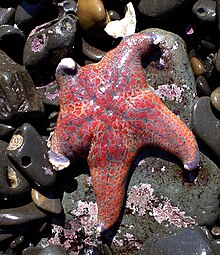Imidazole alkaloids

Imidazole alkaloids are a group of alkaloids whose basic structure contains the imidazole ring system.[1]
Occurrence
[edit]

In nature, imidazole alkaloids are found both as secondary plant compounds and as byproducts of histidine metabolism in marine organisms. One well-known imidazole alkaloid is pilocarpine, which is present in the leaves of Paraguay jaborandi.
For instance, from the seeds of garden cress (Lepidium sativum), various monomeric imidazole alkaloids can be isolated, including semilepidinoside A and semilepidinoside B, as well as dimeric forms such as lepidins B, C, D, E, and F.[2] In the sponge Leucetta chagosensis, a variety of imidazole alkaloids, such as 2-deoxy-2-aminokealiiquinone and Naamine C, have been identified.[3] Imbricatin has been isolated from the starfish Dermasterias imbricata, while martensin A has been obtained from the red alga Martensia fragilis. Notably, the marine sponge Pseudaxinyssa contains odilin.[1]
The Maca plant contains relevant amounts of lepidilin.
Representative
[edit]A well-known imidazole alkaloid is pilocarpine. Other representatives include. cynodin, cynometrin and odilin.[1]
-
(+)-Pilocarpine
-
Cynodine
-
Cynometrine
-
Odiline
Websites
[edit]- Imidazole Alkaloids. In Encyclopedia of Biochemistry, at spektrum.de. Retrieved September 29, 2019.
References
[edit]- ^ a b c Entry on Imidazol-Alkaloide. at: Römpp Online. Georg Thieme Verlag, retrieved {{{Datum}}}.
- ^ Ulrich H. Maier, Heidrun Gundlach, Meinhart H. Zenk: Seven imidazole alkaloids from Lepidium sativum. In: Phytochemistry. 49, 1998, S. 1791–1795, doi:10.1016/S0031-9422(98)00275-1.
- ^ Xiong Fu, John R. Barnes, Trang Do, Francis J. Schmitz: New Imidazole Alkaloids from the Sponge Leucetta chagosensis. In: Journal of Natural Products. 60, 1997, S. 497–498, doi:10.1021/np960694i.




